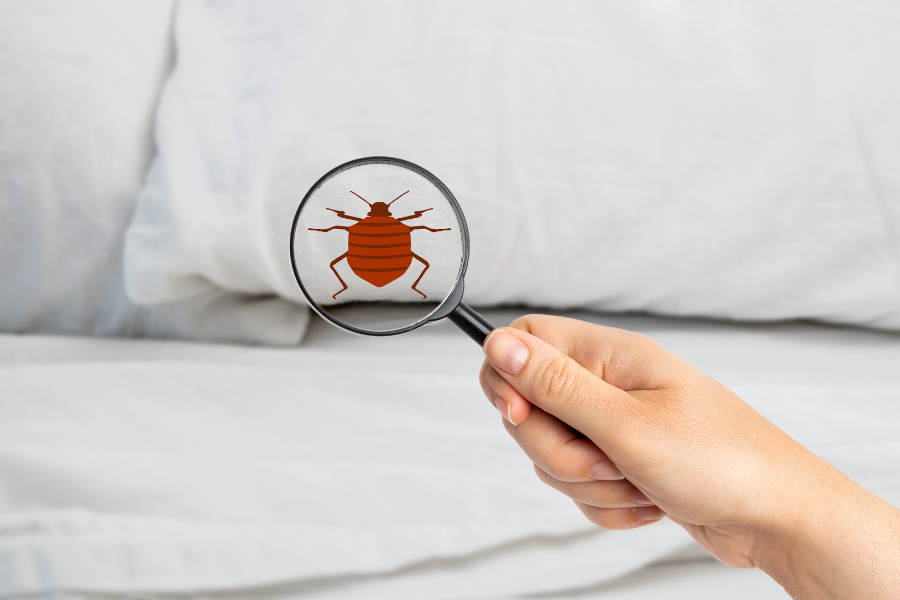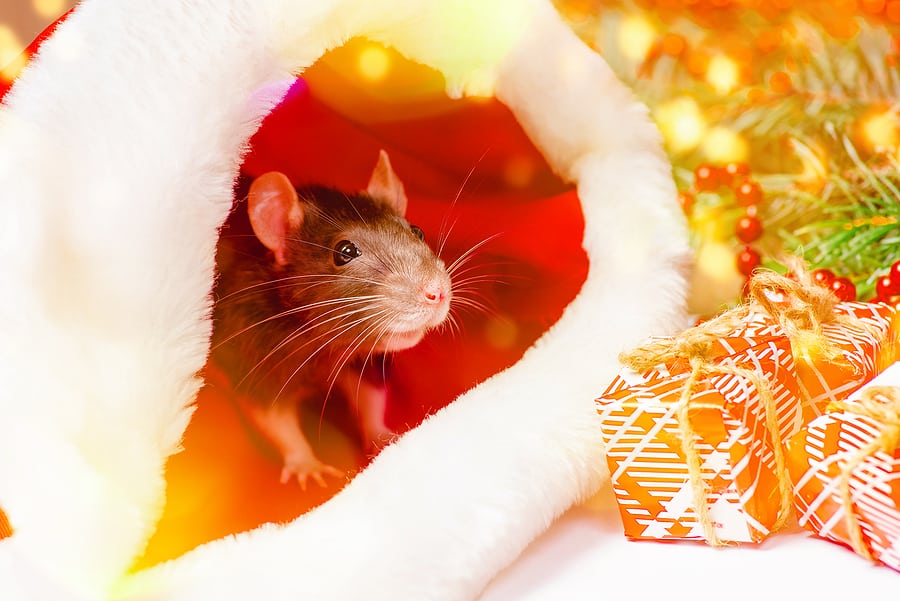READY TO GET STARTED?
REQUEST A FREE ESTIMATE
Fill out the form below or call (888) 466-7849 for a free, no-obligation estimate.

Typically, when temperatures begin to drop, that means many bugs go into a sort of hibernation mode. This isn’t necessarily the case for bed bugs. Being predominantly indoor pests, they tend to survive the colder months. It’s also a big time for them to spread because of all the holiday travels, so always be aware of any pests that could ruin your holiday fun.
There are many ways that bed bugs can spread from one location to another. They will climb into our belongings and can lay their eggs in them. We will then carry these items from a location of infestation to a new location. Even if your bags or items are left outside, it will take a while for them to be harmed by the cold, as they are more resilient to the cold than they are to the heat. And since they will be hiding in our items, they will be protected from the wind and cold air.
Here are some tips to follow while travelling, so you can prevent bed bugs from home with you.
If you believe you have picked up bed bugs while on your travels, be sure to call your local pest control company and they will be able to assist you with a customized plan of action.

The holiday season is a time to enjoy family, eat delicious food, and not worry about pests! Unfortunately, overwintering pests such as spiders, rodents, ants, ticks, and more are looking indoors for food, water, and shelter. During the holiday season, Christmas trees, wreaths, firewood, decorations, and storage boxes provide the ideal opportunity for these pests to hitchhike inside.
Check out our top 3 pest prevention tips for holiday pest control.
Check Your Decorations
Attics, basements, and garages provide perfect storage spaces for our holiday decorations. These areas in your home are dark and secluded, making them the perfect place for pests to invade. Stored decorations provide an undisturbed hiding place for pests such as mice, rats, spiders, and more. These creatures will often crawl into the storage boxes you put away last season, contaminating and destroying your decorations.
To ensure that you do not bring these pests into your main living space, inspect and unpack these items outside first. After the holiday season has ended, pack your decorations like foliage, potpourri, and Indian corn in air-tight containers to help prevent pests for next year.
Check Your Firewood
With colder weather here, many homeowners start utilizing their fireplace, bringing in more firewood from outside. However, it’s crucial to inspect firewood before bringing it inside the home. Pests like spiders, termites, and ants are often found on firewood. Consider placing the firewood outside 20 feet from your home and on a raised platform.
Check Your Christmas Tree & Wreaths
If your family celebrates Christmas, you might opt to buy a real Christmas tree and wreath. While both can showcase the authentic look of Christmas, they also tend to carry pests such as spiders, moths, mites, and even squirrels!
To prevent these unwanted pests from hitchhiking indoors, inspect both items outside and then shake them. Also, check these items for any droppings, gnaw marks, or other damage before bringing them inside.
If you suspect that you have a holiday pest problem, consider reaching out to your local pest control company. These professionals will be able to inspect your home, provide the best pest control plan, and recommend prevention techniques for your home.

With the long-awaited holiday season approaching, many of us plan to travel and visit friends and family. Unfortunately, bed bugs are notorious for hitchhiking their way into hotel rooms, rented houses, family houses, and college dorms. Check out our top tips for preventing bed bugs before you travel this holiday season.
Inspecting Your Room
Before bringing your luggage into the room you are staying in, check thoroughly for signs of bed bugs. It’s more common for hotels to have issues with bed bugs, so it’s important to check each room. Inspect all furniture such as sofa cushions, chairs, and around mattresses corners. One sign of a bed bug infestation is seeing small, dark-colored stains on bedding and the skin shells they’ve shed.
If you suspect a bed bug infestation, ask to be moved or consider another place to stay.
Unpacking Luggage
Bed bugs are small and nocturnal, often allowing them to go unnoticed. Even after inspecting your room without finding any signs of bed bugs, continue to be cautious when unpacking your clothes. It’s recommended that you use the luggage racks instead of placing bags and suitcases on furniture or tables.
Returning Home
Once you have returned home, don’t bring the luggage and bags you traveled with inside. Instead, unpack your items outside the home and thoroughly inspect them. After inspecting your items, wash all your clothes immediately, making sure to run them through a high-heat dryer cycle, as bed bugs cannot withstand high temperatures.
After you have unpacked and washed your clothes, store your suitcases in your garage or storage closet. To be extra cautious, you can also seal your luggage in large, plastic storage bags before bringing them inside.
If you suspect a bed bug infestation in your home, it’s best to contact a professional bed bug control company to assess the situation. A trained professional can help determine the best plan of action, treatment, and prevention plan for your home.

With the holiday season arriving, your business is sure to get plenty of packages to fulfill your customers’ needs. Shipments and deliveries will be expected in and out throughout the day, unfortunately putting your business at risk of a pest infestation. We break down how you can get prepared for commercial pest control before the packages start rolling in!
Know the Signs
Understanding the signs that your delivered packages are infested is the first step to prevention. Pests will often leave infestation signs outside and inside the package. Gnawing marks in the corner of cardboard boxes or containers is a well-known indicator of a rodent infestation. Other red flags include seeing egg cases, discarded wings, insect body parts, droppings, larvae, or the actual pest inside the package. If there is a pest inside a delivery, it is best to take the package outside and isolate it.
Prepare Your Staff
Ensuring that your team understands the signs of pests within packages and deliveries is another step in pest prevention. Educate them on the types of pests they could potentially see, how to inspect each delivery, and the procedures to take if they find an actual pest.
Always Tidy Up
For many businesses, shipments and packages will be delivered either at the front of the business or have a dedicated loading dock. With any unloading area, make sure that the space is always clean and uncluttered. Have the location frequently cleaned and prohibit any food or drinks to help avoid supplying the pests with a food source.
Dealing with an unexpected pest infestation is the last thing you want to do during the hustle and bustle of the holiday season. Ensure that your business has a pest plan in place to help prevent any pest problem that can ruin your reputation.

As we start to gear up for the holidays, many of us begin gathering and storing food supplies for the upcoming months. Unfortunately, these essentials could also be providing stored product pests or “pantry pests” a supply of their own! The most common of these pantry pests, Indianmeal moths and merchant grain beetles, will infest and eat a variety of pantry items such as grains, nuts, chocolates, cake mixes, cookies, and more.
We break down some easy ways to prevent these pests this holiday season so you can get back to what matters most: family time.
Invest in Proper Storage
Utilizing Tupperware-type containers is a great way to keep your pantry organized and keep pantry pests away! Place your grains, uncooked pasta noodles, cookies, or seeds in these containers to protect against pests. Make sure that the containers are made from either glass or plastic, with a tight-fitting lid. Also, consider placing a bay leaf in dry goods such as flour, rice, and other grains – the bay leaf’s smell will help repel many pests.
Inspect Your Groceries
Most of the time, pantry pests are brought into the home from items that have already been infested, such as cardboard, plastic bags, or paper grocery bags. Before purchasing groceries, inspect the food packaging prior to placing them into your cart to buy. If you notice that there is an opening, do not purchase and let an employee know. Before entering your home with groceries, inspect and go through ingredients to make sure there hasn’t already been a pest infestation.
Seal Cracks
Sealing cracks and crevices throughout your home is essential for not letting these pests in. Check around your stovepipes and water pipes for any openings and seal them if needed. Additionally, moisture is a major attraction to any pests. Eliminate any water coming from leaking pipes or clogged drains. Consider investing in a dehumidifier to help with moisture control.
If you suspect pantry pests or have seen them, throw out anything infested and do a thorough cleaning of the entire area. Contact a local pest control company to help identify the pest and provide the best treatment and prevention plan.